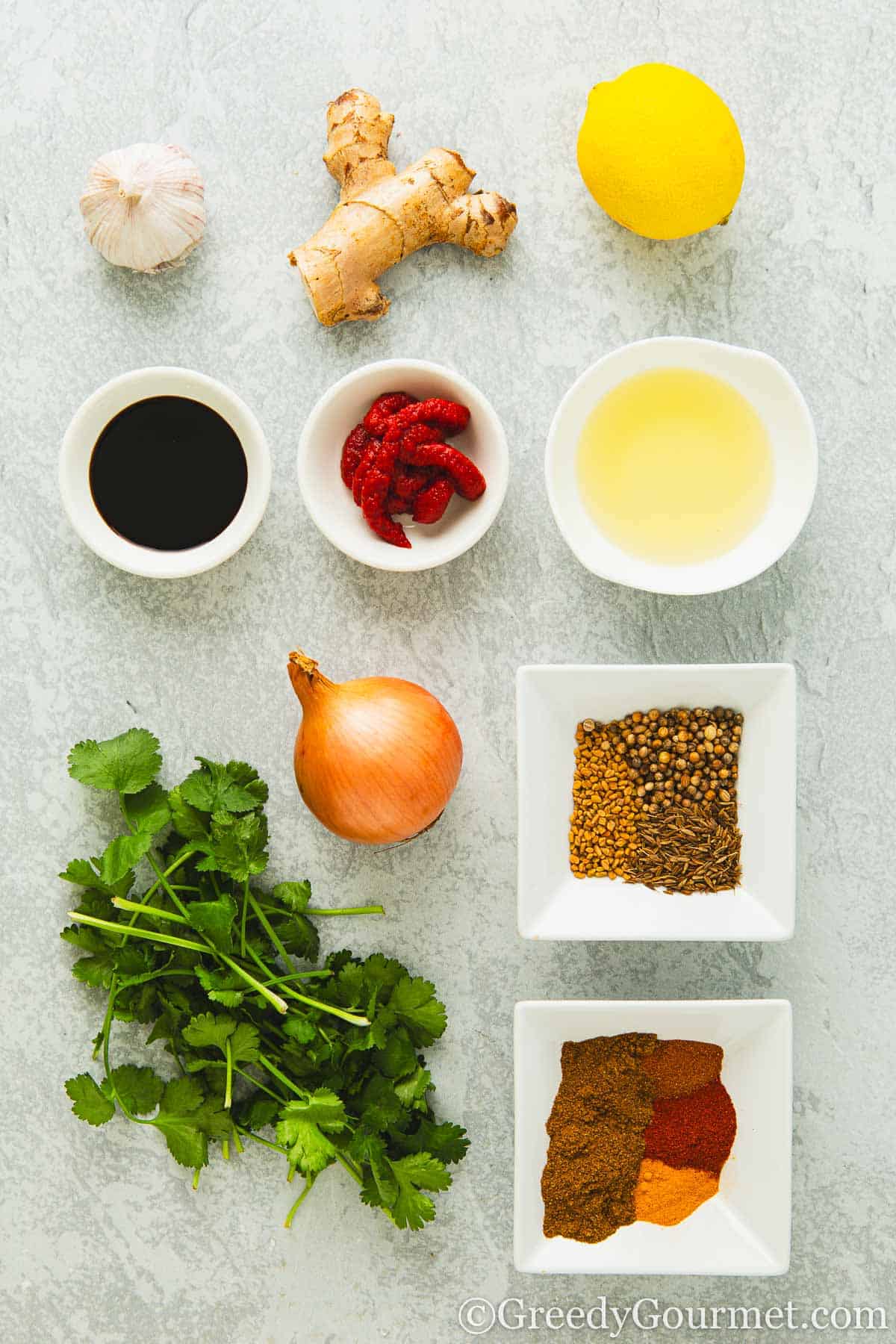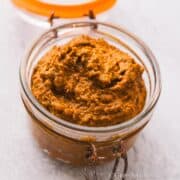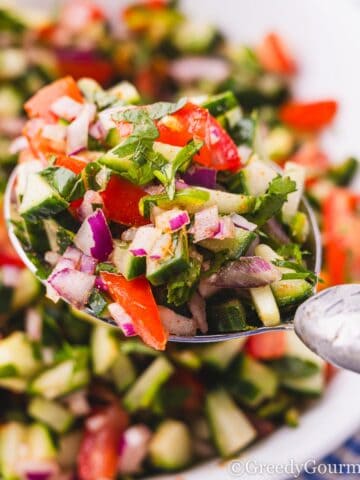Homemade tikka paste is a thing of true beauty! A selection of ground spices mixed with tomato, onion, garlic, and a drop of oil, it's like a flavor bomb that brings so much character to your homemade curries.

So, do you want to learn to make your own tikka paste? Let's get cooking!
Why you'll love this tikka paste recipe
- Homemade tikka masala paste adds an element of authenticity to tikka curries
- Make your own curry paste and your dish will taste all the more satisfying
- This can be used as a fish, vegetable or chicken marinade to elevate your curry cooking
Equipment you'll need
There are a few key pieces of equipment that you'll need before making tikka masala paste:
- Medium-sized pan – a good quality pan is needed for toasting your spicy seeds before grinding them up into a beautiful fragrant powder
- Food processor – this is for blending up the ingredients to form a fragrant curry paste
- Spice grinder – when it comes to getting the best flavour and scent out of your spices, you can't beat a spice grinder. A mortar and pestle will do, but a spice grinder is quicker and easier
- Airtight container – store your homemade tikka paste in airtight containers to increase the life span of your spice mixture
How to make tikka paste

- Assemble all your ingredients.

- Fry the cumin, coriander and fenugreek seeds in a bit of oil until their flavors are released.

- Add the onions and fry for 5 minutes. Add the garlic and ginger, then fry for another 2 minutes. Add the dried spices and keep stirring.

- Stir in the tomato paste and tamarind puree.

- Place everything, including the cilantro, lemon juice and salt to a food processor and blend until smooth. Store in an airtight container.
Top Tip
Go for freshly ground spices for the fullest flavour.
How To Use Tikka Paste
Marinating
Tikka paste is ideal for marinating meats, vegetables, and paneer. For chicken breasts or other meats, mix 2-3 tablespoons of tikka paste with plain yogurt and marinate for at least 2 hours before grilling, baking, or cooking. Vegetables can be coated directly with tikka paste mixed with a little oil, then roasted or grilled until tender. For paneer, marinate cubes in tikka paste and oil, then grill or pan-fry until golden and slightly charred.
Tikka Masala
Use this homemade paste as the base for a rich tikka masala curry. Sauté 2-3 tablespoons of tikka paste, then add tomato and coconut cream or coconut milk. Let it simmer with cooked chicken, paneer, or vegetables until the flavors meld together. This paste also works well in vegetarian masalas with chickpeas, tofu, or mixed vegetables.
Would you like to save this?
Stir-Fry
Incorporate tikka paste into quick stir-fries by adding 1-2 tablespoons to your favorite stir-fried meat, tofu, or vegetables. Cook until everything is well-coated and heated through, then serve over rice or noodles for a flavorful, easy meal.
Tikka Rice
Add depth to rice dishes by stirring tikka paste into cooked rice or biryani. You can also use it in a one-pot rice dish by sautéing the paste with onions, adding rice and broth, and cooking until the rice is tender and infused with the tikka flavors.
Dips & Sauces
Mix tikka paste with Greek yogurt to create a spicy, tangy dip for chips, veggies, or as a sauce for grilled meats, served with a garlic naan. For a quick aioli, blend tikka paste with mayonnaise to pair with fries, burgers, or grilled seafood.
Popular substitutes
- Cumin Seeds: Substitute with ground cumin if seeds are unavailable. Use 1 teaspoon ground cumin for 1 tablespoon cumin seeds.
- Coriander Seeds: Substitute with ground coriander if seeds are unavailable. Use 1 teaspoon ground coriander for 1 tablespoon coriander seeds. You could also use chopped fresh coriander.
- Fenugreek Seeds: Substitute with ground fenugreek or fenugreek leaves (also known as kasuri methi). Use ½ teaspoon ground fenugreek or 1 teaspoon fenugreek leaves.
- Chili Powder: Kashmiri chili powder is preferable but if you can't get hold of it, substitute with paprika (for color with mild heat) or cayenne pepper (for more heat, but less color). Adjust the amount based on your heat preference.
- Tamarind Paste: Substitute with lemon juice, lime juice or vinegar for acidity, though it will slightly alter the flavor. Use about 1 tablespoon of lemon juice or vinegar for 1 tablespoon of tamarind paste.
- Tomato Puree: Substitute with tomato paste (use slightly less, as it is more concentrated) or fresh tomatoes (blended into a tomato purée). Use ½ tablespoon tomato paste or 2 tablespoons fresh tomato puree. At a push, you could even use tomato sauce.
- Fresh Cilantro: Substitute with parsley if cilantro is unavailable. This will change the flavor but still provide a fresh, herbal note.
- Vegetable Oil: Substitute with olive oil or sunflower oil. These oils will work well, though they may slightly alter the flavor profile.
Top tips for tikka paste
- Use freshly ground spices for a tikka masala paste with maximum taste and fragrance.
- Don't hesitate to use substitutions if needed. You can cater it to make your own tikka paste that suits your tastes.
- Be sure to cook tomato and tamarind paste for a few minutes to soften the flavour.

What is tikka paste made of?
This staple of Indian cuisine consists of a blend of select spices, pureed tomato, lemon juice and a touch of oil.
What is the difference between tikka and tandoori paste?
Homemade tikka and tandoori paste are similar, although they typically use a different mix of spices. The main difference between tikka and tandoori is how the meat is cooked – a tikka usually requires skinless and boneless chicken chunks, typically chicken breast, whereas chicken tandoori normally uses leg meat too.
Is tikka curry paste the same as tikka masala paste?
These homemade pastes use very similar spices. However, tikka masala paste often has a hotter flavor owing to extra spices being used in the past, such as red chili powder.
Is tikka paste hot?
Homemade tikka curry paste is medium hot. You can increase the heat by using more than ½ a teaspoon of chili powder – I would recommend a teaspoon for a nice kick. Of course, you can also reduce the heat of your homemade tikka paste by leaving chilli powder out altogether, while using mild paprika rather than hot paprika.
What does tikka mean in Indian?
The Punjabi word “tikka” translates into English as small pieces of meat. Masala means "mixture".
What makes it a tikka?
A tikka features small pieces of boneless meat or vegetarian alternatives, including the likes of tofu and paneer. The pieces are marinated in spices and yogurt, strung through a skewer, and then cooked over a grill or a barbecue.
How long does homemade tikka paste last?
When stored in an airtight container, this homemade tikka paste will last in the refrigerator for up to a month.
How do you use curry paste as a marinade?
Simply follow the instructions below, combining the spices and other ingredients listed, then rub the paste onto your chosen meat or vegetarian alternative and cook as per the chosen recipe.
More amazing spice mixes and marinades
Once you've perfected this homemade tikka masala recipe, why not try your hand at one of these:
- Chicken seasoning – this amazing homemade dry rub will take chicken and other meat to another level of deliciousness!
- Jerk spice – an incredible Jamaican spice mixture that will add so much flavour to your favourite meat, fish and vegetable dishes
- Korma curry paste – the secret to a classic korma? A homemade korma paste. This recipe guarantees an amazing homemade curry and is one you'll go back to again and again
- Onion paste – a big flavour bomb that will take your Indian curry recipes to a whole new level
📖 Recipe

Homemade Tikka Paste Recipe
- Total Time: 25 minutes
- Yield: 1 cup 1x
- Diet: Vegan
Description
Create bold flavors at home with this Homemade Tikka Paste recipe, packed with aromatic spices it's perfect for adding a kick to your Indian-inspired dishes.
Ingredients
- 1 tablespoon cumin seeds
- 1 tablespoon coriander seeds
- 1 teaspoon fenugreek seeds
- 2 tablespoons vegetable oil
- 1 medium onion, finely chopped
- 3 garlic cloves, minced
- 1.5 inches fresh ginger, minced
- 2 teaspoons garam masala
- 1 teaspoon turmeric powder
- 1 teaspoon hot paprika
- ½ teaspoon chili powder
- 1 tablespoon tomato puree
- 1 tablespoon tamarind paste
- ¼ cup fresh cilantro leaves and stems, chopped
- ½ teaspoon sea salt
- ½ lemon, juiced
Instructions
- Heat the vegetable oil in a medium-sized pan over medium heat.
- Add the cumin seeds, coriander seeds, and fenugreek seeds (if using) to the oil and fry them for about 1-2 minutes until they start to sizzle and become fragrant.
- Add the finely chopped onion to the pan and sauté until golden brown, about 5-7 minutes.
- Stir in the minced garlic and ginger, cooking for about 2 minutes until fragrant.
- Add the garam masala, turmeric powder, hot paprika, and chili powder to the pan.
- Stir and cook for 1-2 minutes to combine the flavors with the onions and fried spices.
- Add the tomato puree and tamarind paste to the pan, mixing well with the spices and onions.
- Cook for another 2-3 minutes to allow the flavors to meld together.
- Transfer the entire mixture to a blender or food processor. Add the fresh cilantro, sea salt, and lemon juice.
- Blend until smooth. If the paste is too thick, you can add a little more oil or a small amount of water to achieve the desired consistency.
- Use the paste immediately to marinate chicken, paneer, or vegetables, or store it in an airtight container in the refrigerator for up to a month.
- Prep Time: 10 minutes
- Cook Time: 15 minutes
- Category: Curry Paste
- Method: Pan Fry
- Cuisine: Indian
Nutrition
- Serving Size: cup
- Calories: 397
- Sugar: 7 g
- Sodium: 1231 mg
- Fat: 30.7 g
- Saturated Fat: 22.6 g
- Trans Fat: 0 g
- Carbohydrates: 27.4 g
- Fiber: 7.8 g
- Protein: 5.3 g
- Cholesterol: 0 mg





Make my day! - Share your thoughts...